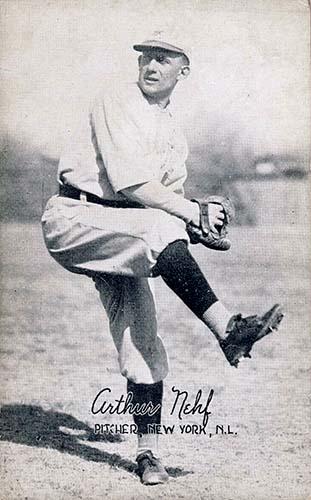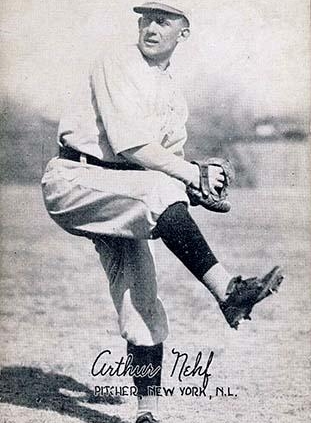August 27, 1921: Giants beat Pirates 3-1 to complete 5-game sweep
 On Wednesday, August 24, 1921, the Pittsburgh Pirates and New York Giants began a five-game series at the Polo Grounds with a doubleheader. The Pirates were in first place with a 7½-game lead over the second-place Giants, and nine games ahead in the lost column. The Pirates were a confident group, evidenced by having their team picture taken before the games for the anticipated World Series program.1
On Wednesday, August 24, 1921, the Pittsburgh Pirates and New York Giants began a five-game series at the Polo Grounds with a doubleheader. The Pirates were in first place with a 7½-game lead over the second-place Giants, and nine games ahead in the lost column. The Pirates were a confident group, evidenced by having their team picture taken before the games for the anticipated World Series program.1
Pittsburgh, under manager George Gibson, was led by Rabbit Maranville at shortstop and outfielders Carson Bigbee and Max Carey, with Wilbur Cooper and Babe Adams anchoring the pitching staff. Maranville had voiced his displeasure at the team picture being taken, proclaiming, “Pictures for what? Wait until we have won the pennant before we have our pictures taken.”2
John J. McGraw’s Giants featured outfielders Ross Youngs and George Burns, third baseman Frankie Frisch, shortstop Dave Bancroft, and first baseman George “High Pockets” Kelly. The pitching staff had been bolstered by deals that brought the Giants Art Nehf and Jesse Barnes from the Boston Braves, Phil Douglas from the Chicago Cubs, and Fred Toney from Cincinnati.
The Giants swept the Pirates in the doubleheader behind pitchers Nehf and Douglas, reducing their deficit to 5½ games. A 5-2 New York win behind Toney followed the next day. The Giants made it four in a row a day later when Douglas came back on one day’s rest to beat the Pirates 2-1. In that game, the Pirates had 10 hits but could score only a single run.
The final game of the series was to be played on Saturday, August 27. For Pittsburgh, it was as close to a must-win game with a month remaining in the season. If the Pirates lost, their lead would shrink to 2½ games and the Giants would have considerable momentum.
Nehf returned to the mound for the Giants. His victory in the first game of the series had given him five wins over the Pirates in 1921. The Pirates were starting Hal Carlson, who had made only five starts and won just two games so far in the season. Carlson was a spitball pitcher who had won 14 games in 1920. The spitball was outlawed after the 1920 season but each team could submit a list of two pitchers who could continue throwing the pitch until they left baseball.3 Carlson was not on the Pittsburgh list. Apparently, Barney Dreyfuss, the owner of the Pirates, was adamantly opposed to the spitball.4 Not being able to throw a spitball probably explained why Carlson had won just two games.
In the top of the first with two outs, Maranville blooped a single to left and scored on a double by Possum Whitted as Burns in center field came up short on a shoestring catch.5 Carlson retired the Giants in order in the bottom of the inning. In the top of the second, Walter Schmidt singled for the Pirates with two outs but was stranded at first when Carlson struck out. Once again, the Giants went out in order.
The third inning and the top of the fourth proved uneventful. In the bottom of the fourth, after Carlson had retired the first 11 Giants batters, Frisch singled for New York’s first baserunner of the game, but Youngs flied out in foul territory down the left-field line to end the inning. After the Pirates went out in the top of the fifth, Meusel singled with one out in the Giants half. He attempted to steal second but was thrown out by catcher Schmidt. Johnny Rawlings ended the inning by flying out to left field.
Bigbee led off the top of the sixth for the Pirates with a single. He reached second on a sacrifice by Carey but was stranded as both Maranville and Whitted flied out. The Giants went out in order in the bottom of the inning as did the Pirates in the top of the seventh.
As the Giants came to bat in the bottom of the seventh inning, Carlson had allowed only two hits but that was soon to change. With one out, Frisch and Youngs singled to center. Kelly popped out to second, but Meusel singled to right, scoring Frisch. When right fielder Carey juggled the ball and made an errant throw, Youngs, running at full speed with two outs, also scored, giving the Giants a 2-1 lead.6 This was Meusel’s eighth hit in 16 at-bats during the series. Rawlings’s groundout ended the inning.
In the top of the eighth after an out, Cotton Tierney pinch-hit for Carlson and grounded out to third. Bigbee ended the inning by popping out to second. In the bottom half, Jimmy Zinn replaced Carlson and was greeted by a single by Giants catcher Earl Smith. Nehf sacrificed Smith to second base. Zinn then walked both Burns and Bancroft, loading the bases.
As the Pirates replaced Zinn with Whitey Glazner, the Giants sent Casey Stengel to run for Smith at third. Glazner got Frisch to fly to center field and Stengel scored after the catch, making the Giants’ lead 3-1. Youngs ended the inning by grounding out.
Nehf retired Carey, Maranville, and Whitted in the ninth to end the game. The Pirates’ lead had been reduced to 2½ games. Nehf now had six wins against the Pirates in 1921. Meusel once again got the key hit for the Giants. The July trade that brought him from Philadelphia to New York was proving to be extremely beneficial to the Giants. Carlson pitched well for the Pirates and was the hard-luck loser, allowing just one earned run on seven innings.
The Giants had superlative pitching throughout the series, allowing the Pirates only six runs. Nehf and Douglas each won two games while Toney won the other. All were complete games. Asked about the sweep, McGraw responded, “Not bad. But Pittsburgh is still in first place.”7
An interesting sidelight was that McGraw phoned Christy Mathewson, his favorite Giant, after each game of the series. Mathewson, who threw three shutouts in the Giants’ 1905 World Series championship, was in a sanitorium at Saranac Lake, New York. He had been exposed to mustard gas in while serving in World War I and had been diagnosed with tuberculosis, possibly having contracted it from his brother Henry Mathewson, who died from the disease in 1917.8 Years later, Blanche McGraw recalled her husband’s side of the phone conversations during which McGraw stated, “We can take this Pittsburgh crowd now, for sure. … They don’t have much left.”9
While McGraw was finally displaying some confidence, the Pirates were still ahead by four games in the loss column and were playing 22 of their remaining 32 games at their home ballpark, Forbes Field. The Giants, who had struggled away from the Polo Grounds, were on the road for 19 of their remaining 28 games. Would this home-field advantage allow the Pirates to prevail and overcome the impact of losing five in a row to the Giants?
After this final game of the series, the Pirates were scheduled to play the Brooklyn Robins in a three-game series at Ebbets Field. Pittsburgh won two of the three but the Giants swept Chicago in a three-game series at the Polo Grounds. The Pirates’ lead was down to 1½ games.
The Giants lost four of their next six games, but Pittsburgh was also struggling. After sweeping a doubleheader from Philadelphia on September 7 at the Polo Grounds, the Giants were just a half-game behind the Pirates. This sweep of the Phillies was the beginning of a 10-game winning streak. On Friday, September 9, after an offday, the Giants defeated the Robins 6-2 at the Polo Grounds while the Pirates lost. New York was in first place by a half-game. After beating the Robins the next two days, the lead was 1½ games. While playing on the road for the rest of the season, the Giants increased their lead and won the NL pennant.
As McGraw had earlier predicted, the Yankees won the AL pennant, setting the stage for the first subway World Series. The Giants prevailed in the best-of-nine Series, 5 wins to 3, their first World Series victory since 1905.
Sources
The Lyle Spatz and Steven Steinberg book 1921: The Yankees, the Giants, & the Battle for Baseball Supremacy in New York (Lincoln: University of Nebraska Press, 2012) was invaluable in providing a chronology of the Giants’ 1921 season. The author additionally relied on the following game accounts from Baseball-Reference.com and Retrosheet:
https://www.baseball-reference.com/boxes/NY1/NY1192108270.shtml
https://www.retrosheet.org/boxesetc/1921/B08270NY11921.htm
The author wishes to also thank John Fredland for his excellent suggestions to improve the readability of the essay and Kevin Larkin for his fact-checking.
Notes
1 Lyle Spatz and Steve Steinberg, 1921 The Yankees, the Giants, & the Battle for Baseball Supremacy in New York (Lincoln: University of Nebraska Press, 2012), 245.
2 Spatz and Steinberg, 245.
3 https://www.baseball-reference.com/bullpen/Spitball.
4 Ernie Fuhr, “Hal Carlson,” SABR BioProject, https://sabr.org/?posts_per_page=10&s=Hal+Carlson.
5 “Nehf Weaves Spell Over Dazed Pirates,” New York Times, August 28, 1921: 78.
6 “Nehf Weaves Spell Over Dazed Pirates”: 79.
7 Noel Hynd, The Giants of the Polo Grounds (Los Angeles: Red Cat Tales Publishing LLC, 2018), 326.
8 Eddie Frierson, “Christy Mathewson,” https://sabr.org/bioproj/person/christy-mathewson/.
9 Hynd, 326.
Additional Stats
New York Giants 3
Pittsburgh Pirates 1
Polo Grounds
New York, NY
Box Score + PBP:
Corrections? Additions?
If you can help us improve this game story, contact us.


